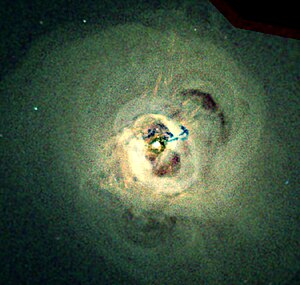Portal:Radiation astronomy/Image/21


Chandra X-ray Observatory observations of the central regions of the Perseus galaxy cluster are at left. Image is 284 arcsec across. Right ascension (RA) 03h 19m 47.60s Declination (Dec) +41° 30' 37.00" in the constellation Perseus. Observation dates: 13 pointings between August 8, 2002 and October 20, 2004. Color code: Energy (Red 0.3-1.2 keV, Green 1.2-2 keV, Blue 2-7 keV). Instrument: ACIS. Credit: NASA/CXC/IoA/A. Fabian et al. On the right is a composite image og the behemoth galaxy NGC 1275, also known as Perseus A, that lies at the centre of Perseus Galaxy Cluster. Hubble data from the Advanced Camera for Surveys covers visible-light wavelengths and is shown in the red, green and blue. Radio data from NRAO's Very Large Array at 0.91 m was also used. In this composite image, dust lanes, star-forming regions, hydrogen filaments, foreground stars, and background galaxies are contributions from the Hubble optical data. The X-ray data contributes to the soft but violet shells around the outside of the centre. The pinkish lobes toward the centre of the galaxy are from radio emission. The radio jets from the black hole fill the X-ray cavities. Chandra data from the ACIS covers X-ray wavelengths from 0.1771 to 4.133 nm (0.3-7 KeV).